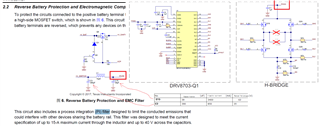Other Parts Discussed in Thread: TIDA-01389, DRV8706-Q1

How to calc C3,C15 ,L1?
Why is C3 & C15 ripple current different?
This thread has been locked.
If you have a related question, please click the "Ask a related question" button in the top right corner. The newly created question will be automatically linked to this question.

How to calc C3,C15 ,L1?
Why is C3 & C15 ripple current different?
Hi,
Thank you for your post. We are still investigating your question and need more time. Will feedback to you in early of next week.
regards
Shinya
Hi,
How to calculate C3, C15, L1 ? -- L1 and C3 form a second-order low-pass filter to prevent variations of PVDD from propagating to +V_SWITCH. This helps reduce conducted EMI from the board. The corner frequency of the low-pass should be well below the PWM switching frequency (if the motor uses PWM for speed control), typically about 20 kHz. In this case, with 10 uH and 390 uF, the corner frequency is at 1/(2*pi*sqrt(10uH*390uF)) = 2.5 kHz. Designers could pick larger component values for L and C to get more attenuation at 20 kHz, but at some point the cost and size of the components become a limitation. Similarly, C15 provides a low-impedance path to ground for any high-frequency components of PVDD, so that also reduces the conducted emissions from the board. C15 with L1 also forms a low pass in the opposite direction, in case there are any oscillations on +V_SWITCH which should be filtered before reaching PVDD. So again, bigger is better, up to the point that cost and size of C15 become excessive. Usually the values of these components will be determined during EMC testing.
Why is C3&C15 ripple current different? -- the ripple current on C15 can be higher than C3 because C15 is more directly affected by the transitions of current from PVDD, such as during PWM of the motor. The ripple current of C3 is lower than C15 due to the filtering effect of L1. It is not so directly affected by variation in load current from PVDD.
By the way, the TIDA-01389 design uses the DRV8703 device, which is previous generation device. I would suggest to look at the DRV8706-Q1 as a newer and more cost effective high-performance single-motor gate driver.
regards
Shinya